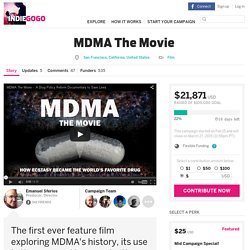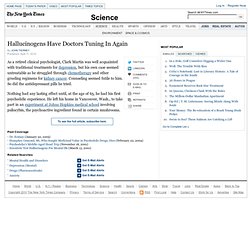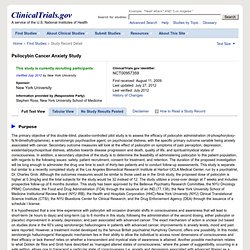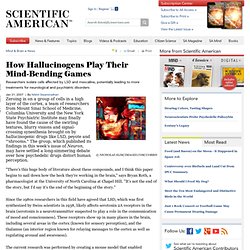

MDMA The Movie. Watch our First Short Film on MDMA Therapy A Dangerous Party Drug?

Despite the drug war, the recreational use of MDMA has spread around the globe, and its use is only rising. Unfortunately, so are “ecstasy-related” fatalities. Although tiny compared to most other recreational drugs (about 15 deaths per year in the US), ecstasy or molly-related fatalities generate disproportionate media attention. What causes ecstasy-related deaths? Shelley's Parents: Harm Reduction Saves Lives We Need Your Help! We need to raise $100,000 to complete our second phase of production. Estimated Budget Breakdown We Will Release Content Along the Way Your donation will also allow us to continue to post extended interviews and other short videos on our website throughout the production and post-production phase. A Few of Our Perks We have a few physical products we are offering as perks that we can send you right away. The Film Team Organizations Endorsing the Film More About the Film Medical vs.
Psychedelic Research. Hallucinogens Have Doctors Tuning In Again - NYTimes.com - (Buil. Nothing had any lasting effect until, at the age of 65, he had his first psychedelic experience.

He left his home in Vancouver, Wash., to take part in an experiment at Johns Hopkins medical school involving psilocybin, the psychoactive ingredient found in certain mushrooms. Scientists are taking a new look at hallucinogens, which became taboo among regulators after enthusiasts like Timothy Leary promoted them in the 1960s with the slogan “Turn on, tune in, drop out.” Now, using rigorous protocols and safeguards, scientists have won permission to study once again the drugs’ potential for treating mental problems and illuminating the nature of consciousness.
After taking the hallucinogen, Dr. Martin put on an eye mask and headphones, and lay on a couch listening to classical music as he contemplated the universe. “All of a sudden, everything familiar started evaporating,” he recalled. Today, more than a year later, Dr. In one of Dr. Psilocybin Advanced Cancer Anxiety Study. The primary objective of this double-blind, placebo-controlled pilot study is to assess the efficacy of psilocybin administration (4-phosphoryloxy-N,N-dimethyltryptamine), a serotonergic psychoactive agent, on psychosocial distress, with the specific primary outcome variable being anxiety associated with cancer.

Secondary outcome measures will look at the effect of psilocybin on symptoms of pain perception, depression, existential/psychospiritual distress, attitudes towards disease progression and death, quality of life, and spiritual/mystical states of consciousness. In addition, a secondary objective of the study is to determine the feasibility of administering psilocybin to this patient population, with regards to the following issues: safety, patient recruitment, consent for treatment, and retention. The duration of the proposed investigation will be long enough to administer the drug one time to each of thirty-two patients and to conduct follow-up assessments. Investigating the Mechanisms of Hallucinogen-Induced Visions Using 3,4-Methylenedioxyamphetamine (MDA): A Randomized Controlled Trial in Humans.
Background The mechanisms of drug-induced visions are poorly understood.

Very few serotonergic hallucinogens have been studied in humans in decades, despite widespread use of these drugs and potential relevance of their mechanisms to hallucinations occurring in psychiatric and neurological disorders. Methodology/Principal Findings We investigated the mechanisms of hallucinogen-induced visions by measuring the visual and perceptual effects of the hallucinogenic serotonin 5-HT2AR receptor agonist and monoamine releaser, 3,4-methylenedioxyamphetamine (MDA), in a double-blind placebo-controlled study. We found that MDA increased self-report measures of mystical-type experience and other hallucinogen-like effects, including reported visual alterations. Conclusions/Significance Drug-induced visions may have greater intensity in people with poor sensory or perceptual processing, suggesting common mechanisms with other hallucinatory syndromes. Trial Registration Clinicaltrials.gov NCT00823407. How Hallucinogens Play Their Mind-Bending Games: Scientific American - (Build 20100722150226)
Zeroing in on a group of cells in a high layer of the cortex, a team of researchers from Mount Sinai School of Medicine, Columbia University and the New York State Psychiatric Institute may finally have found the cause of the swirling textures, blurry visions and signal-crossing synesthesia brought on by hallucinogenic drugs like LSD, peyote and "'shrooms.

" The group, which published its findings in this week's issue of Neuron, may have settled a long-simmering debate over how psychedelic drugs distort human perception. "There's this huge body of literature about these compounds, and I think this paper begins to nail down how the heck they're working in the brain," says Bryan Roth, a pharmacologist at the University of North Carolina at Chapel Hill. "It's not the end of the story, but I'd say it's the end of the beginning of the story. " U.N.C., Chapel Hill's Roth says that the new study's localization of LSD's effect on the pyramidal neurons in level V makes sense. Research Institute. All Heffter Supported Research.
ShulginResearch.org. Ask Dr. Shulgin Online: Archive Index. Nowe drogi w psychoterapii. Entheogenic Review. .bodycard xxxx.